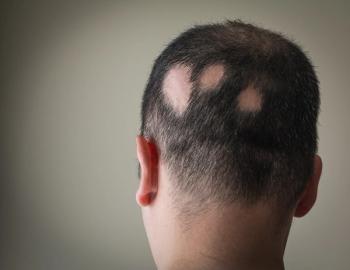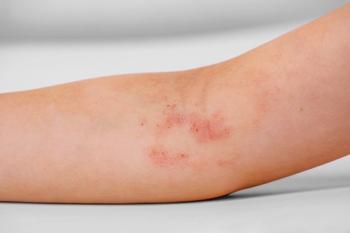
Cystic Hygroma in an Infant Girl
Ultrasonography showed a large multiseptated cystic mass in the posterior part of the left side of the neck. No obvious vascular flow evident within the mass (Figures 3 and 4).
HISTORY
Full-term, 5100 g girl delivered by spontaneous vaginal delivery after an uncomplicated pregnancy to a 31-year-old gravida 6, para 2 mother. Prenatal ultrasonograms showed normal findings at 17 weeks and 31 weeks, although view of neck was suboptimal at 31 weeks. Neonate cried immediately after birth. Apgar scores, 9 at 1 minute and 9 at 5 minutes.
PHYSICAL EXAMINATION
After delivery, infant noted to have a soft, fluctuant, ill-defined, nontender, nonpulsatile mass measuring 5 13 cm on left posterolateral side of the neck
(Figure 1)
. Overlying skin not warm or discolored; mass not attached to it. Mass transilluminated well
(Figure 2)
.
Figure 1 - This ill-defined mass was present in the left posterolateral part of the neck. The overlying skin was normal.
Figure 2 - Transillumination through the entire mass suggests that the mass is filled with fluid.
Figure 3 - Ultrasonogram of the mass shows that it is composed of multiple, large, cystic spaces separated by thin septae (arrow). Some debris is visible within the fluid. No solid mass was found.
Figure 4 - Color Doppler ultrasonogram of the septated cystic mass in the posterior left neck shows no flow within the cysts, confirming that these are not vessels.
Ultrasonography showed a large multiseptated cystic mass in the posterior part of the left side of the neck. No obvious vascular flow evident within the mass (Figures 3 and 4).
No other unusual physical findings. Normal vital signs; no signs of respiratory distress or dysphagia. No other masses clinically evident on physical examination.
ANSWER: CYSTIC HYGROMA
In children, the differential diagnosis of a neck mass is broad. When a mass is present at birth, however, the differential is more limited. In newborns, diagnostic considerations include branchial anomalies, thyroglossal duct cyst, thymic cyst, teratoma, dermoid cyst, lymphangioma, and hemangioma. A soft, fluctuant, ill-defined, transilluminating mass in the posteriolateral part of the neck at birth suggests a lymphangioma or cystic hygroma.
Cystic hygromas (a type of lymphangioma) are the result of maldevelopment and obstruction of the lymphatic system.1 This leads to sequestrations of lymphatic tissue that do not communicate with the normal lymphatic system. About 50% to 65% of cystic hygromas are present at birth; 90% appear by the second year of life. They are located in the posterior triangle of the neck in about 75% of cases and in the axilla in about 20% of cases. The remainder occur in the mediastinum, retroperitoneum, pelvis, and groin.2 The cyst may be unilocular, but more often there are numerous cysts of various sizes that permeate surrounding structures.
Symptoms are related to the lesion's size and location. Most patients are asymptomatic, but massive congenital lymphatic malformations may cause dysphagia, feeding problems, and airway compromise. Cysts can become enlarged with viral infection or hemorrhage within the lesion because of the presence of nests of poorly supported vascular channels. When lymphangiomas are detected before 30 weeks of gestation, there is a high incidence of associated anomalies-including an abnormal karyotype and hydrops fetalis.3
Surgical resection is the recommended standard of management.4 Elective surgical excision between 4 and 12 months is indicated for asymptomatic patients.3 Complete surgical resection is often difficult, and clinical recurrence is common. Aspiration may temporarily reduce the lesion's size.
Sclerotherapy with OK-432, a lyophilized mixture of Streptococcus pyogenes and benzylpenicillin, has been shown to be an excellent treatment for patients with macrocystic lymphatic malformations.5
References:
- Leung AKC, Robson WLM. Cystic hygroma. Consultant For Pediatricians. 2006;12:787-789.
- Albanese CT, Sylvester KG. Pediatric Surgery. In: Doherty GM, Way LW, eds. Current Surgical Diagnosis and Treatment. 12th ed. New York: McGraw-Hill; 2006:1279-1280.
- Hartman GE, Boyajian MJ, Choi SS, et al. Surgical care of conditions presenting in the newborn. In: MacDonald MG, Mullett MD, Seshia MM, eds. Avery's Neonatology: Pathophysiology and Management of the Newborn. 6th ed. Philadelphia: Lippincott Williams & Wilkins; 2005:1099-1100.
- Fageeh N, Manoukian J, Tewfik T, et al. Management of head and neck lymphatic malformations in children. J Otolaryngol. 1997;26:253-258.
- Peters DA, Courtemanche DJ, Heran MK, et al. Treatment of cystic lymphatic vascular malformations with OK-432 sclerotherapy. Plast Reconstr Surg. 2006;118:1441-1446.
Newsletter
Access practical, evidence-based guidance to support better care for our youngest patients. Join our email list for the latest clinical updates.














